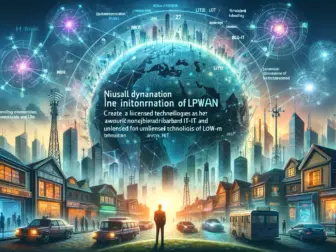Tag - LPWAN
Exploring LPWAN Technology: The Driving Force Behind IoT Connectivity and Its Impact on Future Networks
Exploring LPWAN Technology: The Driving Force Behind IoT Connectivity and Its Impact on Future Networks
In the burgeoning sphere of the Internet of Things (IoT), the need for efficient and far-reaching communication technologies is paramount. Low-Power Wide-Area Network (LPWAN) technology has emerged as a pivotal solution, bridging the gap between long-range communication and low-power requirements. LPWAN defines a category of wireless telecommunication networks designed to support IoT devices that require long battery life, low bandwidth, and long-range communication.
One of the most compelling advantages of LPWAN is its ability to enable devices to communicate over large distances—often several kilometers—while maintaining low power consumption. This is particularly beneficial for IoT applications where devices are deployed in remote or challenging environments and need to operate for years without requiring battery replacement. Examples of these applications include agricultural sensors, smart meters, and asset tracking systems.
LPWAN technologies operate on various frequencies and protocols, with some of the most prominent being LoRaWAN, Sigfox, and NB-IoT. LoRaWAN stands out for its use of the proprietary LoRa modulation technique, which ensures communication can penetrate urban and indoor environments effectively. Sigfox, on the other hand, operates on a unique ultra-narrowband technology allowing it to provide network coverage with minimal energy consumption. NB-IoT is a standard-based LPWAN technology developed by the 3GPP and is designed to be deployed within the existing cellular network infrastructure.
Each LPWAN technology offers a unique set of features catering to specific use cases. For instance, LoRaWAN is often favored for its open ecosystem and flexibility, allowing for private and public network deployments. Sigfox is typically chosen for its extreme simplicity and low cost for applications that only need to send small amounts of data. NB-IoT benefits from the reliability and security of legacy cellular networks, making it suitable for critical applications that require guaranteed service levels.
The impact of LPWAN on future networks is multifaceted. By enabling the vast deployment of IoT devices, LPWAN is a catalyst for the development of smart cities, where everything from traffic management to environmental monitoring can be optimized. In agriculture, LPWAN is revolutionizing precision farming techniques by allowing farmers to collect real-time data on crop conditions, thereby improving yields and reducing resource consumption.
Moreover, LPWAN is set to play a critical role in asset tracking and supply chain management. By providing the ability to track goods across vast distances, LPWAN can help logistics companies improve the efficiency and security of their operations. This is particularly relevant in the context of global trade, where the ability to monitor the condition and location of goods can lead to significant cost savings and risk reduction.
In the industrial sector, LPWAN technologies facilitate predictive maintenance and machine-to-machine communication, driving the fourth industrial revolution by enabling smarter and more autonomous factories. The low power requirement ensures that sensors and devices can be installed in locations where replacing batteries frequently would be impractical or impossible.
Despite its many benefits, LPWAN is not without its challenges. One of the main concerns is network scalability, as the number of connected devices continues to grow exponentially. Additionally, there is the issue of interoperability between different LPWAN solutions and existing network infrastructures.
In conclusion, LPWAN technologies are at the forefront of IoT connectivity, providing the critical infrastructure needed to support the anticipated explosion of connected devices. With its combination of long-range, low power, and low cost, LPWAN is expanding the realm of possibility for IoT applications, promising to be a cornerstone of future networks that will shape industries and everyday life.

